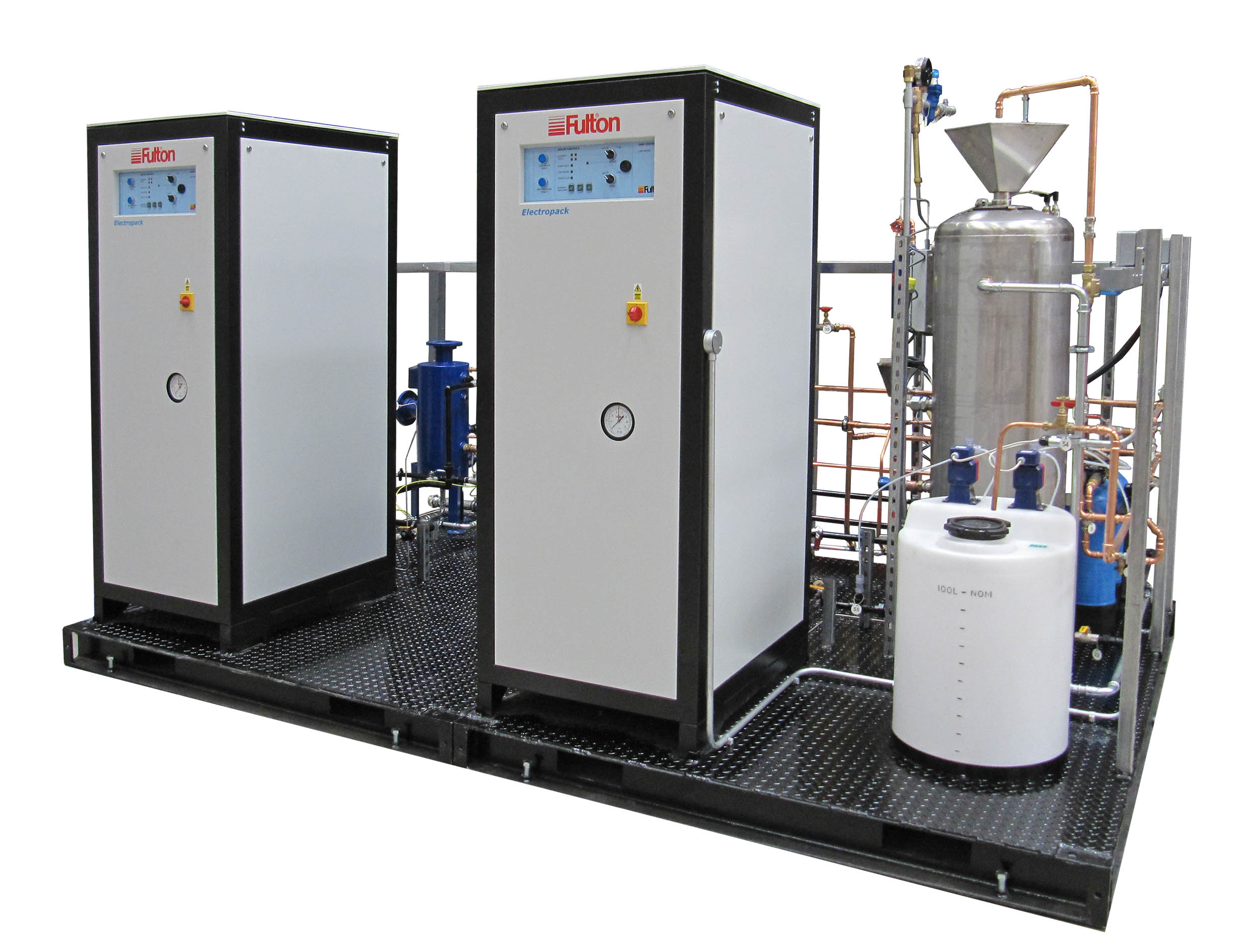
In this article, Fulton managing director Carl Knight delves into the importance of BG13 and the insights it provides into how to ensure the safe operation of electric powered steam boilers.
Guidance for the Safe Operation of Electrically Powered Steam Boilers (Ref: BG13) is a guidance document intended to assist the managers, designers, operators, maintenance personnel and Competent Persons (CP) of new and existing steam boiler systems. Developed and written by the Combustion Engineering Association (CEA) and in consultation with other stakeholders – like Fulton – within the steam boiler industry. It serves as a vital resource to those named and addresses key issues including design, installation, safe operation, maintenance requirements, and compliance with legal standards.
The document covers various dangers and challenges including loss of feed water, over-pressure, overheating, electrical safety, and water treatment. Electric boilers – classified as small, medium, or large – encompass two main types: electric boilers and electrode boilers. Electric boilers utilise fully immersed heating elements, while electrode boilers employ conducting probes or electrodes to directly heat the water.
BG13 applies to industrial and commercial electrically powered steam boiler plants with a working pressure up to 32 bar gauge. It excludes steam boilers exceeding 37 MW nett rated thermal input or above 32 bar gauge working pressure, as well as coffee boilers, jet type electrode boilers, and hot water boilers. Nevertheless, the principles outlined in BG13 can still be applied where suitable and applicable, even to excluded boiler types.
DESIGN & INSTALLATION
Proper design and installation are fundamental to the safe operation of electric steam boilers. BG13 outlines design considerations such as sizing the boiler to meet the specific requirements of the application, ensuring adequate ventilation, and implementing appropriate safety features such as pressure relief valves and automatic shutdown systems.
To guarantee compliance with BG13 standards, installation should be undertaken by qualified professionals and follow manufacturer guidelines and relevant regulations.
BOILER OPERATION
This section outlines operational requirements and routine checks for electric boiler systems. Employers must conduct site-specific risk assessments to determine appropriate controls, supervision levels, and maintenance. Before use, boilers must be examined by a competent person and subsequently tested according to a Written Scheme of Examination (WSE).
Boiler instructions should cover safe operation, daily checks, start-up procedures, safe work practices, and notification of significant operational changes. System re-starts following lock-out require a suitably experienced operator to avoid potential risks.
Routine testing of controls, limiters, and water quality is crucial for safe and efficient operation. Testing frequency should be based on risk assessment, manufacturer's instructions, and operational requirements. Records of tests and maintenance activities must be maintained for audit purposes.
Water level controls need specific testing, with results logged and corrective actions taken as necessary. Feed water and boiler water checks, including chemical dosing and quality assessments, should be conducted regularly.
Special consideration must be given to water treatment for standby and unused boilers to prevent scale build-up and ensure system integrity.
PERSONNEL & RESPONSIBILITIES
The user/owner must appoint competent individuals responsible for daily boiler operation, with competence entailing relevant education, training, and experience.
Operators must be capable of recognising the limits of their expertise and seeking assistance when necessary and their duties are determined by site-specific risk assessments. Employers have general duties to provide safe workplaces and adequate staff training under the Health & Safety at Work Act 1974, MHSWR, and PUWER. These responsibilities cannot be delegated to employees or third parties.
Qualified electricians or electrical engineers must manage electrical issues associated with boilers, ensuring electrical safety, compliance with regulations, and implementing safety measures. Individuals monitoring boiler alarms must be adequately trained to respond appropriately to alarm conditions, ensuring safety before seeking assistance. Access during emergencies should be restricted to trained personnel.
Maintenance personnel require sufficient knowledge and training to carry out their duties safely, performing tasks only for which they are trained and competent. User/owners hiring subcontractors for specialised tasks must ensure their competency, oversee their work, and ensure compliance with legal requirements and safety standards.
Manning and supervision levels are determined by detailed risk assessments, considering factors like automation, location, water quality, and operational scenarios. Electric boilers require a competent operator present during start-up and lockout. Advanced automation may still necessitate full-time supervision for steam security or other reasons.
MAINTENANCE, REPAIR & MODIFICATION
Boiler systems must be properly maintained to prevent danger, adhering to PSSR Regulation 12 and PUWER Regulation 5. Responsibility for maintenance should be clearly defined, with the user/owner ensuring all personnel are competent, boiler operators handing over safely, and maintenance checked before the boiler is back in operation.
Steam leaks should be promptly repaired, and maintenance activities should be documented, including maintenance frequency, and logs kept up to date.
Before any modifications or repairs, a risk assessment must be conducted and the CP should assess the effects on pressure equipment, reviewing the WSE as required.
Significant repairs must address causal factors and comply with PSSR Regulation 13, documenting alterations and ensuring equivalent standards.
OPERATOR TRAINING
Employers must ensure all personnel possess adequate knowledge of boiler systems and receive training under PUWER Reg 9. Training should be ongoing, structured, and updated to reflect technological advancements and legislative changes, and should cover boiler operation, controls, emergency procedures, legal aspects, and site-specific elements.
Competence levels and training requirements must be reviewed, especially with system modifications, and employers must maintain training and assessment records securely for audit purposes.
Personnel, including managers and operators, must undergo regular work audits and periodic reassessment of training. Training validation must include written and/or oral assessments with recorded results.
Essential elements of boiler house training should include understanding Steam Boiler Water Treatment (SBWT) principles to maintain water quality. Recommended courses include CertIBO for operators, DipBOM for managers, and SBWT training as part of the CEA suite.
PERIODIC INSPECTION
A boiler must be examined according to a WSE that details parts, examination types, and intervals, and may be written and certified by an independent or in-house CP.
The examination includes two phases: "out of service" and "in service.", with the latter involving verifying protective devices such as pressure gauge, controller, safety relief valve, and water level controls.
Post-examination, the CP should issue a report with recommendations, while other devices such as control system power failure and critical alarms should also be checked and tested.
ENERGY & THE ENVIRONMENT
Efficient boiler energy management is crucial for cost reduction, safety, and plant longevity, so seeking expert advice before altering operating parameters ensures safety, environmental compliance, and efficiency.
Options such as metering for efficiency monitoring, water treatment, energy improvement devices (e.g., variable speed drives), and plant scheduling for optimisation should all be considered. It is worth noting that simply reducing steam pressure may not always enhance efficiency, so measurement is therefore recommended to demonstrate efficiency.
Electric boilers are not subject to emissions regulations, but environmental considerations such as noise and waste streams require attention. Water discharged must meet utility restrictions, and resources on legislation and guidance are available from government and industry websites.
Large organisations may need to comply with the Energy Saving Opportunities Scheme (ESOS).
CONCLUSION
The CEA’s BG13 stands as a comprehensive guide for the management of electric steam boilers, addressing design, installation, operation, and maintenance best practices. It serves as a vital resource for professionals involved in boiler systems, covering essential aspects such as safety and compliance with legal standards.
By adhering to BG13 guidelines, organisations can ensure the safe and efficient operation of boiler systems, mitigating risks and maximising longevity. Furthermore, considerations for energy management and environmental impact underscore the document's relevance in promoting sustainable practices within industrial settings.
Overall, BG13 provides a comprehensive framework for ensuring the optimal performance and safety of electric steam boilers, contributing to the overall efficiency and sustainability of industrial operations.





